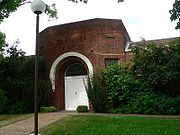
Grainger Museum
Encyclopedia

Percy Grainger
George Percy Aldridge Grainger , known as Percy Grainger, was an Australian-born composer, arranger and pianist. In the course of a long and innovative career he played a prominent role in the revival of interest in British folk music in the early years of the 20th century. He also made many...
, located in the grounds of the University of Melbourne
University of Melbourne
The University of Melbourne is a public university located in Melbourne, Victoria. Founded in 1853, it is the second oldest university in Australia and the oldest in Victoria...
, Australia
Australia
Australia , officially the Commonwealth of Australia, is a country in the Southern Hemisphere comprising the mainland of the Australian continent, the island of Tasmania, and numerous smaller islands in the Indian and Pacific Oceans. It is the world's sixth-largest country by total area...
.
In the early 1920s, Grainger began to develop an idea for an autobiographical museum so that "all very intimate letters or notes should be deposited in an Australian Grainger Museum, preferably in birth-town Melbourne". Grainger was a devotee of words derived from Anglo-Saxon and used the word 'hoard-house' for museums generally, but agreed to the word 'museum' in this case.
The Museum was designed by architects Gawler and Drummond, with input and funding from Grainger himself. It was built between 1935 and 1938, and officially opened in December 1938. Until 1989, when the Bradman Museum devoted to the life of Sir Donald Bradman
Donald Bradman
Sir Donald George Bradman, AC , often referred to as "The Don", was an Australian cricketer, widely acknowledged as the greatest batsman of all time...
was opened in Bowral
Bowral, New South Wales
-Attractions:Bowral is perhaps the best known of the towns and villages of the Southern Highlands, and in recent years has become the commercial centre of the Wingecarribee Shire. Bowral is known for its boutiques, antique stores, gourmet restaurants, and rich coffee culture.Bowral is home to the...
, the Grainger Museum was the only autobiographical museum in Australia.
The Grainger Museum was closed in 2003 for seven years, for restoration and conservation work, after waterproofing issues were detected. It reopened on 17 October 2010.
Among displays of original manuscripts and scores, field recordings, artworks, photographs and personal items, are Grainger’s whips and other items relating to his sado-masochism (located in the aptly named "Lust Branch"), the contents of his bedside cabinet, and a gallery devoted to his mother’s suicide. There are also sound-making devices Grainger used to make "Free music".
The entire Grainger collection amounts to 50,000 items of correspondence (with people such as Edvard Grieg
Edvard Grieg
Edvard Hagerup Grieg was a Norwegian composer and pianist. He is best known for his Piano Concerto in A minor, for his incidental music to Henrik Ibsen's play Peer Gynt , and for his collection of piano miniatures Lyric Pieces.-Biography:Edvard Hagerup Grieg was born in...
, Frederick Delius
Frederick Delius
Frederick Theodore Albert Delius, CH was an English composer. Born in the north of England to a prosperous mercantile family of German extraction, he resisted attempts to recruit him to commerce...
, Richard Wagner
Richard Wagner
Wilhelm Richard Wagner was a German composer, conductor, theatre director, philosopher, music theorist, poet, essayist and writer primarily known for his operas...
and Pyotr Ilyich Tchaikovsky
Pyotr Ilyich Tchaikovsky
Pyotr Ilyich Tchaikovsky Pyotr Ilyich Tchaikovsky Pyotr Ilyich Tchaikovsky (Russian: Пётр Ильи́ч Чайко́вский ; often "Peter Ilich Tchaikovsky" in English. His names are also transliterated "Piotr" or "Petr"; "Ilitsch", "Il'ich" or "Illyich"; and "Tschaikowski", "Tschaikowsky", "Chajkovskij"...
) and over 100,000 items in total, only a small proportion of which are on display.
The Grainger Museum is open Tuesday to Fridays, and Sundays, from 1 pm to 4:30 pm.

